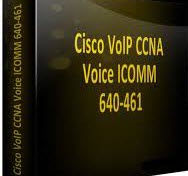
“Hi guys, now I´m going to prepare CCNA Voice, I´ve some videos of 640-460 and Official Exam Certification Guide. My lab consists in two cisco 4506c with iPhones 794x series but… anyone suggest me any other kind of material?”—Oscar
“I am confused right now. Hopefully someone will clarify this for me. I have been studying for the CCNA voice with the official exam cert guide from cisco press which covers 640-460… I was just about ready to schedule my test when I read that the exam to obtain your CCNA voice is the 640-461… Can someone please advise?”
…
 All right, many Cisco learners and users may face these similar problems of Cisco CCNA Certifications. Now we will focus on CCNA Voice Exam, such as what is exact Cisco CCNA Voice Exam, main areas covered on the 640-461 exam and Cisco’s published exam topics.
All right, many Cisco learners and users may face these similar problems of Cisco CCNA Certifications. Now we will focus on CCNA Voice Exam, such as what is exact Cisco CCNA Voice Exam, main areas covered on the 640-461 exam and Cisco’s published exam topics.
The previous iteration of the CCNA Voice certification had an enterprise and commercial option that were provided through two different exams that could be taken to fulfill the requirements for the certification. These exams included the Implementing Cisco IOS Unified Communications (IIUC)–640-460 (commercial option) and the Cisco Voice over IP (CVOICE) – 642-436 (enterprise option); both of which have been since retired.
 The 640-461 exam Introducing Cisco Voice and Unified Communications (ICOMM) v8.0 exam is associated with the CCNA Voice certification. This exam tests a candidate’s knowledge of the architecture, components, functionalities, and features of Cisco Unified Communications solutions. It also tests the knowledge needed to perform tasks such as system monitoring, moves, additions and changes on Cisco Unified Communications Manager, Cisco Unified Communications Manager Express, Cisco Unity Connection, and Cisco Unified Presence. Candidates can prepare for this exam by taking the ICOMM v8.0 Introducing Cisco Voice and Unified Communications Administration v8.0 course..
The 640-461 exam Introducing Cisco Voice and Unified Communications (ICOMM) v8.0 exam is associated with the CCNA Voice certification. This exam tests a candidate’s knowledge of the architecture, components, functionalities, and features of Cisco Unified Communications solutions. It also tests the knowledge needed to perform tasks such as system monitoring, moves, additions and changes on Cisco Unified Communications Manager, Cisco Unified Communications Manager Express, Cisco Unity Connection, and Cisco Unified Presence. Candidates can prepare for this exam by taking the ICOMM v8.0 Introducing Cisco Voice and Unified Communications Administration v8.0 course..
The new ICOMM exam focuses on the convergence of voice and data on the network and wraps the contents from the previous two exam options into a single exam. Specifically the new exam focuses on four different Cisco voice components, these include:
two exam options into a single exam. Specifically the new exam focuses on four different Cisco voice components, these include:
- Cisco Unified Communications Manager
- Cisco Unified Communications Manager Express
- Cisco Unity Connection
- Cisco Unified Presence
These products are of course quite complex and as the associate level of certification is focused at the entry level, the exam will focus on the tasks that would be taken on by an entry level Cisco voice technician.
The specific objects that Cisco lays out for the ICOMM exam include:
Describe the Characteristics of a Cisco Unified Communications Solution
- Describe the Cisco Unified Communications components and their functions
- Describe call signaling and media flows
- Describe quality implications of a VoIP network
Provision End Users and Associated Devices
- Describe user creation options for Cisco Unified Communications Manager and Cisco Unified Communications Manager Express
- Create or modify user accounts for Cisco Unified Communications Manager
- Create or modify user accounts for Cisco Unified Communications Manager Express using the GUI
- Create or modify endpoints for Cisco Unified Communications Manager
- Create or modify endpoints for Cisco Unified Communications Manager Express using the GUI
- Describe how calling privileges function and how calling privileges impact system features
- Create or modify directory numbers
- Enable user features and related calling privileges for extension mobility, call coverage, intercom, native presence, and unified mobility remote destination configuration
- Enable end users for Cisco Unified Presence
- Verify user features are operational
Configure Voice Messaging and Presence
- Describe user creation options for voice messaging
- Create or modify user accounts for Cisco Unity Connection
- Describe Cisco Unified Presence
- Configure Cisco Unified Presence
Maintain Cisco Unified Communications System
- Generate CDR and CMR reports
- Generate capacity reports
- Generate usage reports
- Generate RTMT reports to monitor system activities
- Monitor voicemail usage
- Remove unassigned directory numbers
- Perform manual system backup
Provide End User Support
- Verify PSTN connectivity
- Define fault domains using information gathered from end user
- Troubleshoot endpoint issues
- Identify voicemail issues and resolve issues related to user mailboxes
- Describe causes and symptoms of call quality issues
- Reset single devices
- Describe how to use phone applications
…To be continued…
—Original guide resource from Trainsignal Training
More Related Cisco CCNA Voice Tips:
Top 5 VoIP Concepts to Know for CCNA Voice—VoIP Basic for CCNA Voice


